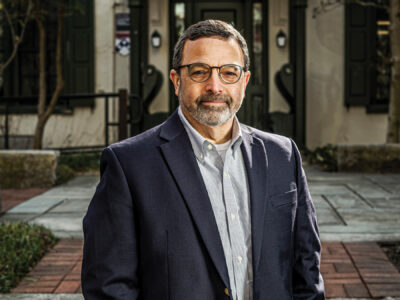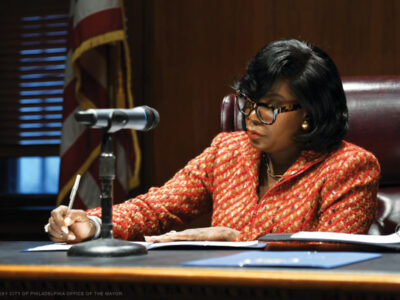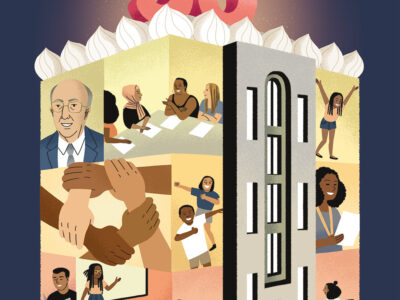The crowd at the Platt Student Performing Arts House laughed appreciatively when President Gutmann quoted Oscar Wilde: “I don’t believe the arts should try to be popular; the public should try to make itself artistic.” But what followed during the fifth annual Penn Arts Leadership Conference (formerly Penn Arts Day) were some serious points.
“The question of where we want to lead the arts is an essential component of the question of how we want to lead our lives,” added Gutmann, who then asked pointedly: “What is the role of the arts in a good life, both as individuals and in the good life of an institution?”
The conference approached those questions from a variety of new angles. One panel featured presentations on arts and culture programs at other institutions that could provide models for Penn—like a Columbia University program that created a website where students “can find out everything” about more than 150 arts groups on campus and that arranged for free student admissions to 27 major art museums in New York. Another panel on “The Creative Economy” took a broader focus, examining “the role of arts and culture in Philadelphia as ‘the next great city.’”
“The good news is that this is a huge industry,” said Peggy Amsterdam, president of the Greater Philadelphia Cultural Alliance. A report by the Alliance, drawing on data provided by 218 non-profit cultural organizations, showed that they had revenues of $573 million and provided 14,000 jobs, along with another 17,000 volunteer positions. These organizations sponsor some 56,000 events annually, generating a total of 12 million visits per year.
The creative economy is the “economy of the future,” said Anne d’Harnoncourt, director and CEO of the Philadelphia Museum of Art, who stressed the need to “enumerate what qualities we need to make the most of.” She cited the city’s physical beauty (both landscaping and the built environment); the fact that Philadelphia is a “city of artists, architects, designers, musicians, photographers, poets, and filmmakers—and we need them to stay here and to flourish”; the range of art and professional schools “of all shapes and sizes”; and the rich variety of cultural institutions, from the Philadelphia Orchestra and the Art Museum (not to mention Penn, “the mother of us all in terms of scale”) to smaller ones like the Fabric Workshop, Print Center, and Brandywine Workshop.
Dr. Robert P. Inman, the Richard K. Mellon Professor of Finance and Economics, provided some background on the economic side of the creative economy. “The arts, from an economist’s perspective, are an incredibly valued commodity for residents of the U.S.,” he said, citing a study that found that high-quality arts and culture correlate with higher housing prices and income growth.
He quickly added a few caveats, though. First, the economic growth is not attributable to the “bohemian folks and artists” themselves, but instead derives from “what that high cultural environment brings into the city and keeps within the city, and that is a highly educated population.” Also, the arts are “neither sufficient nor necessary” for growth. Many culture-challenged cities in the Sunbelt, for example, are growing rapidly, while other urban areas, despite solid cultural offerings, are experiencing little or negative growth.
Denise Scott Brown GCP’60 GAr’65 Hon’94, a principal with the architectural firm Venturi, Scott Brown and Associates, neatly summarized the process by which artists act as the seeds of urban revival—or, to use a more charged term, gentrification. She described driving through some “very derelict, marvelous neighborhoods” where the “buildings are falling apart, and already the artists are moving in, and then the gay people move in, and then the neighborhood begins to get better. Then the ‘ideas people’ move in after them—the people in advertising agencies and the lawyers—and then you have six secretaries start hiring one apartment, and then you’ve got your urbanism going there.”
But artists must be more than a means to an end, she cautioned. While there may be many ideas of what cities need from the arts, it’s also important to ask: “What does the artist need?” Bureaucracies and regulations—from foundations, corporations, and institutions alike—can “squash out” the true creative spirits and “pull in” less visionary artists who will work within those constraints.
“My feeling is that there are problems that aren’t faced when you don’t ask ‘How does art grow? How does it get sustained?’” Scott Brown said.
She also called for greater efforts to bring the joys of art-making and appreciation to the broader, underserved population of Philadelphia. “Think, if you could educate an underclass, how much creativity you will add to the city,” she said. “And, if you help the very poorest people, how much tax you’ll earn in the city.” Another vital group, new immigrants, come here “because they have gumption,” she pointed out. “They are the growth-force of the country they left,” and given the right help, they can “add enormously to the creativity that you will have in this city.”
As an example, Scott Brown pointed to the Charter High School for Architecture and Design, which takes some of the city’s most impoverished young people and “teaches them through design studios,” offering “a kind of education normally reserved for private schools.” Solutions like these, she said, will mean that “the creativity of this whole city—not only its richest but all people—[will] have the chance to flourish.” —J.P.




